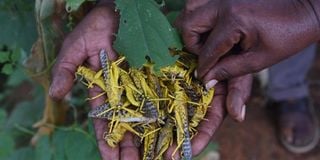Premium
Fight against desert locusts in Turkana, Samburu could take longer

What you need to know:
- The cool temperatures and local winds in Turkana and Samburu counties could limit the immature locusts’ ability to migrate northwards and some of them may remain during the summer, awaiting the rains.
- Agriculture Cabinet Secretary Peter Munya said the swarms in Ethiopia, Somalia and Uganda are expected to be blown by the winds towards Kenya next February but that the country is well prepared to contain the menace.
- The locusts first entered the country on December 28, 2019 through Elwak in Mandera and had spread to 27 counties by March.
The government’s war on desert locusts, that continue to wreak havoc in Northern Kenya, could take longer than expected following reports that they could stay on until the short rains in October.
The cool temperatures and local winds in Turkana and Samburu counties could limit the immature locusts’ ability to migrate northwards and some of them may remain during the summer, awaiting the rains.
The government earlier announced that the locusts could be eliminated by the end of August even as new immature swarms continued to be reported in Samburu while others persisted near the Kenya-Uganda border in Turkana.
Spraying has been done to kill one of the swarms that crossed over to Uganda from Turkana last Wednesday, with control operations against the persistent immature swarms in the Horn of Africa ongoing.
Continued breeding
In a recent forecast, the United Nations’ Food and Agriculture Organization (Fao) said there had been no reports of locusts migrating from Kenya to Sudan, which is currently battling low numbers of the voracious mature locusts.
However, rains that have pounded Sudan this month could offer good breeding grounds, which will consequently increase infestations in coming months.
The August 14 report notes that immature swarms continue to persist in the Northern Somalia plateau, with a large swarm spotted at Hargeisa on Friday.
Other swarms are present in Eastern Ethiopia, between Jijiga, Harar, Dire Dawa and the Djibouti border, and numerous swarms are in the Afar area following immigration from Yemen.
The ongoing rains in Somalia that have prompted large areas of green vegetation to develop will allow breeding and growth of colonies in August and September.
The locusts ravaging Somalia and Uganda could migrate to Kenya once the October rains start as will offer best breeding grounds which will threaten the country’s food security.
Kenya prepared
Agriculture Cabinet Secretary Peter Munya said the swarms in Ethiopia, Somalia and Uganda are expected to be blown by the winds towards Kenya next February but that the country is well prepared to contain the menace.
The CS said State agencies have made significant progress in eliminating the locusts, with focus on the two counties with infestations.
The locusts first entered the country on December 28, 2019 through Elwak in Mandera and had spread to 27 counties by March.
The invasion has been contained in 24 counties so efforts have turned to Turkana and Samburu.
By July, Turkana had reported about 200 hopper band sites in pastures with Turkana South the hardest hit, according to a past Fao report.
The agency notes that swarms in the interior and coastal areas of Yemen have started breeding causing more hopper bands and swarms to form due to continuing rains that have caused flooding in some areas.
Though control measures have been initiated in Oman and hopper bands sprayed, there has been limited mitigation operations in some of the places.
In Pakistan, hopper bands continue to form in Nagarparkar in Southeast Sindh, where fledging has started with some swarms already maturing.
Summer breeding continues along both sides of the Indo-Pakistan border in South West Asia.
Breeding is also underway in Rajasthan in India, where hoppers are forming groups and bands with more hatching expected in the course of August.
Fao has warned that some swarms are expected to arrive from Northern Somalia, posing further risk.
Small numbers of locusts are present in the summer breeding areas of Northern Sahel in West Africa’s Chad, Niger and Mauritania, where local breeding is expected to occur in areas where rains fell recently.





